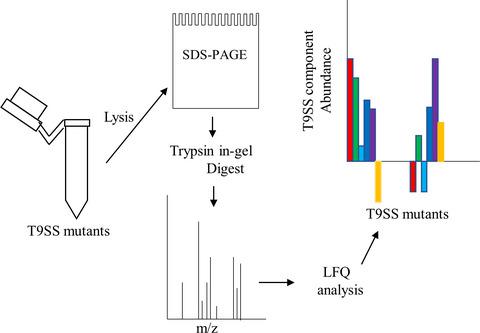当前位置:
X-MOL 学术
›
Mol. Oral Microbiol.
›
论文详情
Our official English website, www.x-mol.net, welcomes your
feedback! (Note: you will need to create a separate account there.)
Quantitative proteomic analysis of the type IX secretion system mutants in Porphyromonas gingivalis.
Molecular Oral Microbiology ( IF 2.8 ) Pub Date : 2020-02-21 , DOI: 10.1111/omi.12283 Dhana G Gorasia 1 , Michelle D Glew 1 , Paul D Veith 1 , Eric C Reynolds 1
Molecular Oral Microbiology ( IF 2.8 ) Pub Date : 2020-02-21 , DOI: 10.1111/omi.12283 Dhana G Gorasia 1 , Michelle D Glew 1 , Paul D Veith 1 , Eric C Reynolds 1
Affiliation

|
Porphyromonas gingivalis is an anaerobic, gram‐negative human oral pathogen highly associated with chronic periodontitis. P. gingivalis utilizes the type IX secretion system (T9SS) to transport many of its virulence factors including the gingipains to the cell surface. The T9SS is comprised of at least 16 proteins and the involvement of these 16 proteins in the T9SS has been verified by creating gene deletion mutants in P. gingivalis. These T9SS mutants are regularly utilized to understand how these proteins function together to allow the secretion of the T9SS substrates. We performed label‐free quantitative proteomic analysis on the T9SS protein mutants in P. gingivalis to understand the relative abundance of each T9SS component in different mutants. The T9SS components were reduced in abundance in the porK, porL, porM, porN, sov and porT mutants, whereas they were increased in the porE, porU, porV, porZ and porQ mutants. Sov and PorW appear to be the lowest in abundance and PorV the highest amongst all the T9SS components in P. gingivalis wild‐type strain. These results are consistent with the proposed role of Sov as the translocation pore in the outer membrane and PorV as the shuttle protein that transports the T9SS substrates between sub‐complexes. Together, the label‐free quantitative proteomics analyses showed that different T9SS mutants have vastly different abundances of the T9SS components. This knowledge will greatly assist in interpreting the phenotype of the T9SS mutants as well as selecting the right mutant for exploring the role of an individual component.
中文翻译:

牙龈卟啉单胞菌IX型分泌系统突变体的定量蛋白质组学分析。
牙龈卟啉单胞菌是一种厌氧,革兰氏阴性的人类口腔病原体,与慢性牙周炎高度相关。牙龈卟啉单胞菌利用IX型分泌系统(T9SS)将其许多毒力因子(包括牙龈蛋白酶)转运至细胞表面。T9SS至少由16种蛋白质组成,这16种蛋白质在T9SS中的参与已通过在牙龈卟啉菌中建立基因缺失突变体进行了验证。经常利用这些T9SS突变体来了解这些蛋白质如何共同发挥作用,以分泌T9SS底物。我们对牙龈卟啉单胞菌中的T9SS蛋白突变体进行了无标签定量蛋白质组学分析了解不同突变体中每个T9SS组分的相对丰度。所述T9SS组分丰度减少了猪肉,PORL,PORM,色情,SOV和端口的突变体,而它们在分别增加孔隙,porU,PORV,位于Porz和porQ突变体。在齿龈假单胞菌的所有T9SS成分中,Sov和PorW的丰度似乎最低,而PorV的丰度最高。野生型菌株。这些结果与Sov作为外膜中的易位孔和PorV作为在亚复合体之间运输T9SS底物的穿梭蛋白的作用相一致。总之,无标记的定量蛋白质组学分析表明,不同的T9SS突变体在T9SS组分上的丰度差异很大。这些知识将极大地帮助解释T9SS突变体的表型,以及选择正确的突变体以探索单个成分的作用。
更新日期:2020-02-21
中文翻译:

牙龈卟啉单胞菌IX型分泌系统突变体的定量蛋白质组学分析。
牙龈卟啉单胞菌是一种厌氧,革兰氏阴性的人类口腔病原体,与慢性牙周炎高度相关。牙龈卟啉单胞菌利用IX型分泌系统(T9SS)将其许多毒力因子(包括牙龈蛋白酶)转运至细胞表面。T9SS至少由16种蛋白质组成,这16种蛋白质在T9SS中的参与已通过在牙龈卟啉菌中建立基因缺失突变体进行了验证。经常利用这些T9SS突变体来了解这些蛋白质如何共同发挥作用,以分泌T9SS底物。我们对牙龈卟啉单胞菌中的T9SS蛋白突变体进行了无标签定量蛋白质组学分析了解不同突变体中每个T9SS组分的相对丰度。所述T9SS组分丰度减少了猪肉,PORL,PORM,色情,SOV和端口的突变体,而它们在分别增加孔隙,porU,PORV,位于Porz和porQ突变体。在齿龈假单胞菌的所有T9SS成分中,Sov和PorW的丰度似乎最低,而PorV的丰度最高。野生型菌株。这些结果与Sov作为外膜中的易位孔和PorV作为在亚复合体之间运输T9SS底物的穿梭蛋白的作用相一致。总之,无标记的定量蛋白质组学分析表明,不同的T9SS突变体在T9SS组分上的丰度差异很大。这些知识将极大地帮助解释T9SS突变体的表型,以及选择正确的突变体以探索单个成分的作用。







































 京公网安备 11010802027423号
京公网安备 11010802027423号